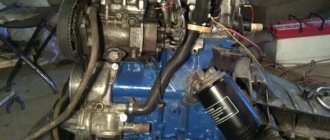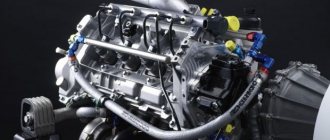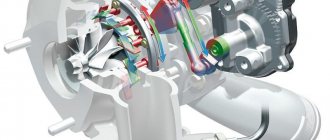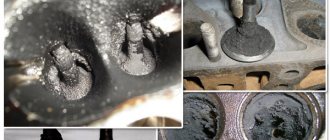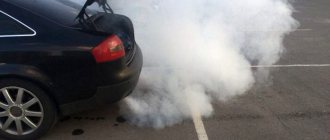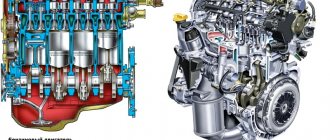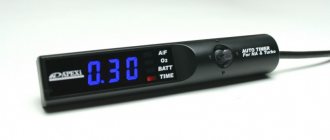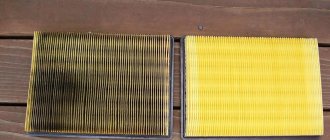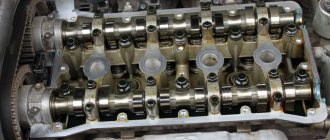Why is diesel breathing?
The concept that the engine is breathing means the appearance of smoke from the oil filler neck, engine oil leaks in various places due to the design of the internal combustion engine (breather), as well as in the area where numerous seals (oil seals) are located. It should be noted that even a relatively new diesel or gasoline engine can breathe a little.
The breather is a device that is a valve. This valve serves to equalize the pressure in containers for various purposes by communicating with the atmosphere. In an internal combustion engine, the breather equalizes the internal pressure in the engine crankcase with the external atmospheric pressure.
The fact is that some of the gases in the cylinder rupture through the sealing rings and enter the engine crankcase, creating excess pressure. To solve this problem, a crankcase ventilation system was created.
Under certain conditions, the crankcase ventilation system does not always successfully cope with increased pressure and removal of excess through the breather. The result is a noticeable increase in oil consumption and oil seal leaks. Sometimes the pressure in the engine rises to such a level that the oil dipstick simply squeezes out.
Why does crankcase pressure increase?
Having noticed oil leaks in the engine compartment and/or a decrease in the oil level in the crankcase, it is necessary to accurately determine that the diesel engine is breathing. This can be done in the following way. It is enough to unscrew the oil filler cap on a warm diesel engine. If you notice bluish smoke coming from the throat, then the problem is obvious.
Cylinder piston group and cylinder head
The main reason that a diesel engine is breathing is the wear of the cylinder-piston group. During the operation of the internal combustion engine, scuffs form on the cylinder walls, the cylinders themselves gradually break and acquire a changed shape of the walls, and the piston rings wear out or break. As a result of heating, the thermal gaps between the piston and the cylinder walls become too large.
In addition to reducing the efficiency of the seal, wear of the rings and their coking are imposed, which deprives the rings of mobility. In such conditions, engine oil enters the combustion chamber abundantly, and the diesel engine emits blue smoke. Also, the gases formed during the combustion of the fuel-air mixture and the engine oil entering the cylinders actively fill the engine crankcase.
If the diesel engine is very worn out, then a major overhaul is necessary, which will mean boring the cylinders, replacing pistons, rings, etc. Accurate diagnosis of CPG problems requires measuring compression to determine the spread of indicators across the cylinders.
In the event that the diesel engine does not breathe much and the malfunction is only at the initial stage (wear of the cylinder walls is within acceptable limits), some auto mechanics resort to the method of decarbonizing the piston rings. This measure is considered temporary, since further long-term operation of the unit after decarbonization of the rings should not be expected. The best solution would be to replace the rings with new ones.
A diesel engine can also vent due to wear of valves, guide bushings, valve seals, etc. Similar to piston malfunctions and ring decarbonization, timing problems can only be effectively eliminated by comprehensive repairs. Replacing valve seals alone does not have a lasting effect.
Engine crankcase ventilation system
Second on the list of main reasons why a diesel engine is breathing is a clogged crankcase ventilation system. The symptoms of a decrease in the throughput of this system resemble wear of the CPG: increased consumption of engine oil, diesel smoking with blue smoke, etc. In some cases, it is possible to normalize engine operation and eliminate excess oil consumption by cleaning the breathers.
The engine is breathing. The reasons why the engine is breathing and how to eliminate them.
In this article we will talk about why the engine is breathing, what this means in the future, and what problems can arise when diagnosing an engine with such a disorder. Let's start with the fact that any, even normal, serviceable engine will breathe, because the piston rings cannot hold all the air compressed in the cylinders. Some of this air passes through the piston rings and creates excess pressure inside the engine. Such pressure, as everyone probably understands, does not lead to anything good; because of it, oil will begin to be squeezed out of all kinds of oil seals.
Well, since you are already here, the problem described here has affected you too. You realized this when you opened the filler cap and saw a good stream of bluish smoke flying out of the engine (car, foreign car), or on your MAZ or KamAZ, or other heavy vehicle, almost the same flow of gases flies out of the breather as from the exhaust, or maybe Does your MTZ knock out the dipstick? It doesn’t matter, everyone has the same problem. However, its causes and solutions are different.
Breather oil: what to do and how to find the cause
Let's start with the fact that during engine operation, so-called crankcase gases accumulate in the crankcase. To prevent excess pressure from being created, there is a special valve for ventilation. This solution allows the closed crankcase to communicate with the atmosphere. This valve is the breather. In simple words, a breather on an internal combustion engine is actually needed to equalize the pressure inside the engine.
It should be noted that in the crankcase gases mix with oil mist. As a result, lubricant particles enter the breather. Although there is a special oil trap inside the device, a certain part of the oil may escape out. Given this information, minor contamination of the system is acceptable, which is normal. In cases where a lot of lubricant leaks, you should look separately for why oil is leaking from the breather.
On injection engines, traces of oil getting into the throttle area are noticeable, the power unit also loses its throttle response and power, and fuel consumption increases noticeably. It turns out that to check it is necessary not only to inspect the outer surfaces under the hood, but also to remove the air filter, throttle assembly, etc.
Why does oil leak through the breather?
If oil appears from the breather, there may be several reasons
Taking into account various features, before self-diagnosis, you need to pay attention to additional symptoms
- First of all, the oil presses as a result of significant wear of the piston rings. This means that gases from the combustion chamber penetrate through the seal into the crankcase, after which too high pressure is created there. Excess pressure causes oil to flow out through the breather.
- Another possible cause could be a clogged oil deflector drain. In this case, gases and oil particles that are no longer able to pass through normally exit through the breather rather than through the cleaner.
- Also on the list is a significant reduction in air filter capacity. In this case, the engine simply does not have enough air at the inlet. The result is the appearance of oil in the filter housing and on the filter itself.
- Possible problems with the breather itself should not be ruled out. As a rule, the valve fails, the passage hole in the breather becomes clogged, etc. Normal ventilation is disrupted, exhaust gases enter the internal combustion engine crankcase and increase the pressure.
- In some cases, overfilling engine oil much higher than the recommended level causes the excess to leak out through the breather. It turns out that excess oil simply presses out of the engine. In such a situation, you should check the lubricant level and adjust it if problems are detected.
Crankcase ventilation
First you need to understand the design of the breather. Everything is quite simple - a hose or metal tube connects the crankcase and the upper part of the engine, creating a system for compensating pressure and reducing it, if necessary. The system also usually includes an oil separator, which prevents lubricant from escaping and returns it back to the engine.
Gas ventilation is usually designed so that air from the crankcase is supplied to the intake tract and used for operation. The design includes a crankcase ventilation valve (CVGV), which, when the pressure is exceeded, opens the membrane and releases the excess, thereby ensuring normal operation. If for some reason the valve is stuck in the open position, then air will be supplied to the intake, creating a vacuum in the engine, which has a bad effect on its operation and increases diesel fuel consumption.
If the valve fails in the closed position, excessive pressure will be created inside the crankcase and the oil will begin to be squeezed out through the seals, dipstick, etc. Also, large quantities of lubricant can enter the cylinders, which is also undesirable. In this case, oil consumption increases and blue smoke often appears.
Important!
The reason may also be clogging of pipes or other elements of the system; here it is important to check all components to eliminate the problem.
Cleaning the crankcase ventilation system of VAZ 2108, 2109, 21099 cars
Contamination of the engine crankcase ventilation system on VAZ 2108, 2109, 21099 vehicles leads to a decrease in the efficiency of removing crankcase gases from it into the carburetor and further into the afterburning cylinders. As a result, the pressure in the crankcase increases.
The engine oil located there under pressure begins to be expelled through the crankshaft and camshaft seals, the valve cover gasket, its oil filler plug, and is thrown into the air filter housing. As a result, the carburetor becomes clogged, the engine begins to “trouble” and stall, the spark plugs become covered with soot, power and throttle response decrease, engine oil waste increases, etc.
Similar symptoms may occur when the engine piston group wears out (rings, pistons, cylinders), but since you need to start looking for the cause of the malfunction from the simplest, you should first clean the ventilation system, since this is less expensive and problematic than a major engine overhaul. The piston can then be checked by measuring the compression in the engine cylinders.
The procedure for cleaning the crankcase ventilation system of an engine with a Solex carburetor 2108, 21081, 21083 and similar ones
We sequentially remove and clean the elements of the small and large branches of the crankcase ventilation. For cleaning we use acetone or gasoline, a toothbrush, and copper wire. We blow with compressed air from a pump or compressor, simultaneously controlling the ease of its passage.
— Cleaning the breather
There is no need to remove it from the engine, just clean the crankcase gas exhaust channel from contaminants with a brush soaked in gasoline. Blow with compressed air. See photo above.
— Cleaning the large exhaust hose
We disconnect it from the pipe on the engine valve cover and from the breather. We wash it with gasoline (pour it inside and shake it, then pour it with water). Blow with compressed air.
the large exhaust hose of the crankcase ventilation system of VAZ 2108, 2109, 21099 cars is removed from the pipe on the cover and the breather
— Clean the crankcase gas exhaust hose into the cavity of the engine air filter housing
Disconnect the hose from the fitting on the valve cover. Remove the air filter housing. Disconnect the hose from the body. We clean the hose itself and the pipe under it on the air filter housing.
hose for exhausting crankcase gases into the engine air filter housing and its pipe on the removed and inverted air filter housing
— Clean the crankcase gas exhaust hose into the throttle body
Disconnect it from the fittings on the carburetor and on the valve cover. We spill, we blow.
— Cleaning the oil separator
To access the oil separator, you must remove the engine valve cover. After unscrewing the two 10mm bolts, disconnect the oil separator from the inner surface of the valve cover. We wash the oil separator with gasoline. Blow with compressed air. Refer to "Cleaning the Oil Separator for Engines 2108, 21081, 21083".
— We clean the fitting and channel with a calibrated hole in the Solex carburetor
Can be cleaned using copper wire without removing the carburetor from the engine. After cleaning, blow with compressed air. In case of severe contamination, the carburetor will have to be removed to clean them.
cleaning the channel and crankcase gas outlet fitting behind the throttle on a Solex carburetor using copper wire
After cleaning, we install all the elements of the engine crankcase ventilation system back, if necessary, replacing the hose clamps or the hoses themselves, if damaged. During the operation of the car, we check whether the oil leakage under the oil seals and seals has stopped. If not, check the serviceability of the engine piston group.
Notes and additions
— On engines 2111 of VAZ 2108, 2109, 21099 cars, cleaning the ventilation system is done in the same way, taking into account the fact that there is no carburetor, but a throttle body with a fitting for a thin hose of the small branch of crankcase ventilation from the valve cover.
— After cleaning the ventilation system on a carburetor engine, it makes sense to clean the air jets of the GDS carburetor of the Solex carburetor and replace the filter element of the engine air filter.
More articles on engines of VAZ 2108, 2109, 21099 cars
— Engine crankcase ventilation system 2108, 21081, 21083, diagram
— Engine crankcase ventilation system 2111, diagram
— Burnt out valve, signs, causes
How to clean the breather
Every caring car enthusiast carefully monitors the technical condition of his vehicle and tries to carry out minor repairs and preventive maintenance in a timely manner. For example, it is necessary to clean the breather as it becomes dirty, since it helps remove gases from the engine crankcase. At a car service center, they will ask you a considerable amount for this simple procedure. However, why pay for something you can do yourself?
You will need
- Cotton gloves, wrenches, screwdrivers, wire. polyethylene.
Instructions
To begin, select the location where you will perform the cleaning procedure. If the weather is dry, then everything can be done right outside. But it’s still better to find a garage with good lighting. Set the car to the parking brake. Turn off the ignition. Open the hood and find the breather . To do this, you can use the operating manual for your car, which should describe in detail the structure of the engine compartment. Typically, the breather is a small square-shaped box to which two pipes are attached. One of the pipes connects the breather to the monoinjector, the second to the air filter.
Remove the upper air filter housing. Don't forget to turn off the power to the on-board power supply system. To do this, remove the negative terminal from the battery. This is necessary in order to avoid short circuits and electric shock. After removing the air filter, you will see the intake manifold, it needs to be removed. Under the intake manifold you will see a breather , which is usually attached to two bolts.
Unscrew the two bolts and carefully remove the breather . Remove the cover from it. Underneath it you will see an oil separator, which is secured with a pin. You need to unscrew the small nut on the stud itself, but not all the way, since it is impossible to put it back on without removing the pan. The tube needs to be cleaned. To do this, use a cleaning rod. It can be made from wire of the desired thickness. Examine the breather for cracks or other defects. There is a small brush at the end of the pipe that extinguishes the flame if there is insufficient compression. It also needs to be cleaned.
After completing all procedures, you need to collect
breather
in reverse order and check its functionality. To do this, start the engine. Carefully remove the cap that covers the oil filler neck. Cover it tightly with a thin piece of polyethylene and secure with an elastic band just below. Polyethylene should not swell. Otherwise, it indicates the presence of pressure. If there is no pressure, then cleaning
breather
but it went well. A slight pressure can only be created when the accelerator pedal is pressed.
Increase in crankcase pressure
When the engine operates, high pressure arises in its cylinders as a result of the release of energy from the combustion process. Under normal conditions, exhaust gases should be discharged from the engine into the atmosphere. However, if the seal between the cylinder and the O-rings is broken, some of the gases may break through and enter the crankcase of the unit, after which excess pressure will form there. The solution to this problem was to create a gas ventilation system in the crankcase.
There are times when the system cannot cope with a large influx of exhaust gases and remove them as intended. In this case, the engine begins to actively consume oil, leaks occur through the oil seals and seals, and there were times when the oil dipstick was squeezed out of the neck due to an excess of gas forces.
The very first, simple motors had a hole with a special oil reflector to remove excess gases, in order to avoid its overconsumption. In modern units, excess gases flow to the air filter, and from there again to the engine; some designs simply discharge them into the manifold.
Why is oil in the engine intercooler bad?
When an engine operates with a turbine, increased heating of the engine occurs, since the injection of air into the combustion chambers leads to its compression and, as a result, the temperature increases. This changes the fuel combustion mode, which can lead to burnout of valves and pistons. The intercooler is a cooling radiator through which the air pumped by the turbine passes. Reasons for lubricant penetration into the intercooler:
- the tray ventilation is not functioning correctly;
- the oil filter is dirty;
- the engine air filter is clogged;
- the turbine drives oil into the intercooler due to a faulty oil seal;
- broken turbine oil return pipe.
The consequences of such breakdowns, left unattended, can lead to high costs for engine restoration.
Troubleshooting
The first thing you need to pay attention to is the color of the exhaust, blue or black smoke, a sign of burnt valves or problems with rings. Next you should check the compression in all cylinders
The value on gasoline internal combustion engines should be within 11-13 MPa. Disconnect the pipes from the valve covers, air vent and breather. Assess the degree of contamination. If the pipes are very dirty or clogged with oil deposits, use gasoline to clean them or a special carburetor cleaner. Check the condition of the oil separator. Unscrew the required bolts to get to this unit. Remove the oil separator and assess its condition. If necessary, clean or rinse followed by drying. Inspect and, if necessary, flush the breather valve. There are situations when the valve gets stuck, resulting in exhaust gases entering the crankcase and creating excess pressure. Remove the part and wash it; in most cases, this will resolve the issue of squeezing oil out of the breather.
Read more: Wires for lighting a car with your own hands
Helpful advice! To distinguish stuck rings from a burnt-out valve, it is enough to perform several manipulations. After checking the compression in the cylinders, determine the cylinder with the lowest value. Then inspect the spark plug of this cylinder; if the rings are lodged in this cylinder, the spark plug will be covered with a thick oil layer. If the valve is burnt out, the spark plug will appear normal without any major abnormalities.
Finally…
The problem of oil escaping through the breather worries many motorists and causes a lot of trouble, but with timely detection of the problem and the right approach, serious consequences can be avoided
It is important to ensure that the oil level is normal, as soon as you find that the engine is taking oil, monitor its level and constantly monitor that it does not fall below the permissible level
Also pay attention to the breather and filter; oil on the air filter in large quantities also does not bode well. Regularly monitor the condition of the engine and all systems, and also promptly correct any malfunction
This will save you from engine overhauls and unnecessary waste.
Any type of car engine has a complex structure. It includes various systems and mechanisms that interact with each other. To ensure the removal of gases formed in the internal cavities of the power unit, the diesel engine is equipped with an effective ventilation system.
Why does oil flow through the breather: reasons
First of all, this is the wear of the CPG. Usually the rings wear out, causing pressure to increase. As a result, the system begins to throw out oil. The release occurs under high pressure, and here filters (usually an ordinary mesh) are not able to help.
Another common reason that the system throws oil through the breather is that the oil deflector is clogged to capacity. If ventilation is impaired, the working fluid in the form of evaporation seeks workarounds around the purifier. Oil begins to fly out through the breather.
The air filter may also become clogged. The system takes in air through other sources, including the breather. But in this case the air mass is taken together with the working fluid.
An increase in the fluid level can also cause it to escape through the breather valve. Sometimes car owners do not spare oil and pour it to the very level, which goes against the manufacturer’s requirements. As a result, excess liquid passes through the prompter.
The breather valve may become stuck, allowing gases to enter the crankcase. This leads to an increase in pressure in the system and, as a consequence, to the release of working fluid through the breather.
Breather oil: what to do and how to find the cause
Let's start with the fact that during engine operation, so-called crankcase gases accumulate in the crankcase. To prevent excess pressure from being created, there is a special valve for ventilation. This solution allows the closed crankcase to communicate with the atmosphere. This valve is the breather. In simple words, a breather on an internal combustion engine is actually needed to equalize the pressure inside the engine.
It should be noted that in the crankcase gases mix with oil mist. As a result, lubricant particles enter the breather. Although there is a special oil trap inside the device, a certain part of the oil may escape out. Given this information, minor contamination of the system is acceptable, which is normal. In cases where a lot of lubricant leaks, you should look separately for why oil is leaking from the breather.
Oil leaks through the breather lead to clogged channels, in some cases soot is formed, etc. Excess soot gets into the engine crankcase, and the lubrication system becomes coked. As a result, loaded parts are less well lubricated and engine wear accelerates. Let us add that traces of oil will not necessarily be visible from the outside in the engine compartment. On engines with a carburetor, if there is a leak through the breather, oil in the air filter housing or on the filter element itself is a characteristic sign of a malfunction.
On injection engines, traces of oil getting into the throttle area are noticeable, the power unit also loses its throttle response and power, and fuel consumption increases noticeably. It turns out that to check it is necessary not only to inspect the outer surfaces under the hood, but also to remove the air filter, throttle assembly, etc.
Why does oil leak through the breather?
If oil appears from the breather, there may be several reasons
Taking into account various features, before self-diagnosis, you need to pay attention to additional symptoms
- First of all, the oil presses as a result of significant wear of the piston rings. This means that gases from the combustion chamber penetrate through the seal into the crankcase, after which too high pressure is created there. Excess pressure causes oil to flow out through the breather.
- Another possible cause could be a clogged oil deflector drain. In this case, gases and oil particles that are no longer able to pass through normally exit through the breather rather than through the cleaner.
- Also on the list is a significant reduction in air filter capacity. In this case, the engine simply does not have enough air at the inlet. The result is the appearance of oil in the filter housing and on the filter itself.
- Possible problems with the breather itself should not be ruled out. As a rule, the valve fails, the passage hole in the breather becomes clogged, etc. Normal ventilation is disrupted, exhaust gases enter the internal combustion engine crankcase and increase the pressure.
- In some cases, overfilling engine oil much higher than the recommended level causes the excess to leak out through the breather. It turns out that excess oil simply presses out of the engine. In such a situation, you should check the lubricant level and adjust it if problems are detected.
Breather device, where is it located?
To better understand the causes of the malfunction, it is useful to understand the design of the unit. As a rule, it looks the same for all manufacturers - in the form of two fittings coming out from under the oil trap in the valve cover. There are large and small breathers.
- The first has a large cross-section and is connected directly to the intake manifold.
- On the second, a 1-2 mm hole was provided, which exits into the intake system through the throttle system. The small breather copes with a small part of the exhaust gases.
Large breather
When crankcase pressure increases, which is common in used vehicles, large amounts of gases escape through the pan. The internal combustion engine crankcase is directly connected to the upper part of the valve mechanism by a special tube. The breather mechanism equalizes the pressure difference by admitting outside air.
Regardless of the location, the purpose of the device is the same. It is noteworthy that the valve has an additional filter that does not allow dirt, water and excess particles to penetrate inside the internal combustion engine along with atmospheric air. The reasons and how to eliminate the formation of excess crankcase gases are described below.
How to detect oil leakage through a diesel breather
The performance of this system is very important for stable engine operation. Oil escaping through the diesel breather is the most common ventilation problem.
If this defect is not detected and eliminated in a timely manner, serious damage to the internal combustion engine may occur:
- oil particles entering the cylinders and manifold;
- clogging and clogging of channels;
- increase in the amount of soot during combustion;
- soot getting into the oil sump;
- coking of oil channels;
- deterioration of the lubrication system.
Signs of oil leaking through a diesel breather include the following effects:
- Leaking grease inside the air filter.
- The presence of abundant oil traces on the outer surface of the filter device of the carburetor engine.
- Oil deposits on the throttle mechanism and the inner surface of the intake manifold.
- Reduced engine power.
- Increased fuel consumption.
Engine overheating
Boiling of coolant in the engine is mainly associated with long operation of the unit at maximum power. If this happens, then the increased formation of lubricant vapors caused by an increase in temperature is added to the volume of gases escaping from the combustion chambers. When the coolant boils, the formation of a vapor lock in the motor head is inevitable. The temperature of the cylinder head increases significantly, which increases oil evaporation. Overheating increases the fluidity of the oil, and it can seep through microcracks in worn oil seals. For this reason, the impeller pumps air with lubricant particles and this affects the functioning of the motor, reducing its wear resistance, as well as worsening operating parameters.
Causes of malfunction
There may be several reasons, the main ones being:
- Contamination and failure of the crankcase ventilation system;
- Malfunctions of the cylinder-piston group;
- Damage to the cylinder head.
To accurately determine what exactly led to the uncharacteristic behavior, it is necessary to diagnose the state of the power plant with the involvement of specialists.
Crankcase ventilation
The unpleasantness and danger of the phenomenon lies in the fact that the user is not always able to identify signs of uncharacteristic behavior in time. As a result, a neglected problem can lead to serious consequences and make the situation much worse.
When the crankcase ventilation stops working, it does not release excess pressure into the atmosphere, but accumulates it inside the crankcase of the power plant. Over time, when the pressure reaches a critical point, the accumulated gases are released through the filter.
In order to avoid troubles and not aggravate them by breakdown, at the first sign of a malfunction of the ventilation system and breather, it is necessary to wash them as quickly as possible. Troubleshooting can be done in two simple ways: disassemble the breather and wash all the necessary parts and the filter from deposits, or add a special detergent additive to the oil, which will eliminate all dirty formations.
Piston rings
One of the reasons that the power plant is breathing may be a problem with the piston rings. During engine operation, some of the exhaust gases leak into the engine crankcase. Over time, the pressure increases, and they begin to look for a way out of the confined space. Due to the fact that the ventilation system is clogged, gases begin to escape from all possible cracks in the seals and seals.
Failure of the rings leads to an increase in pressure in the crankcase, and this in turn leads to an excess of oil consumption. Some part of it is squeezed out through the dipstick, some through the seals, forming a leak. Some oil, through loosely fitting rings, enters the working chamber and burns out there along with the fuel.
Sometimes all these symptoms are accompanied by a flashing light on the car’s dashboard, signaling a breakdown in the engine. To confirm the diagnosis, it is necessary to measure the compression of the power unit. Compression of less than 11 units in any cylinder, together with other phenomena, indicates the occurrence of rings. To eliminate the malfunction, it is necessary to disassemble the unit and carry out repairs.
When carrying out repairs, disassemble the pistons and conduct a full diagnosis of the rings. If they occur, it is necessary to remove the rings; the procedure must be performed with special care, so as not to break the parts
After removal, complete cleaning of the rings and pistons from carbon and deposits is required, special attention must be paid to the grooves; corrosion formed in them must be completely eliminated
Cylinder-piston group
If the check shows no problems with the crankcase ventilation and rings, the next common possible cause may be damage to the cylinder liner surfaces. To eliminate the defect, it is necessary to grind the surfaces and install new rings of the repair size. If the cylinders are worn heavily, engine boring cannot be avoided.
The engine may bleed due to wear of valves, seals, bushings, etc. In any case, an accurate diagnosis and elimination of the cause requires a complete diagnosis and inspection of the motor by a specialist.
The diesel engine is famous for its greater throttle response compared to its gasoline counterpart. Even with less horsepower, it is capable of giving a head start to a more powerful gasoline unit. However, we often hear from car owners about problems with diesel engines. For example, that the diesel engine in their vehicle is breathing. Today we will tell you what it is, whether you should be afraid and how to deal with it.
How to troubleshoot
If you are sure of the reasons why your diesel engine began to breathe, it’s time to start eliminating them.
Problems with crankcase ventilation are relatively easy to fix; it is necessary to adjust or replace the relief valve along with the filter responsible for cleaning the exhaust gases. It is also possible that the problem will be solved by slightly cleaning the breather itself, if the reset mechanism functions correctly. If oil leaks through loose connections, it is necessary to replace the gaskets and seals in the corresponding parts of the structure. In other cases, you will have to almost completely overhaul the engine.
But, do not forget that small oil leaks on the body of a diesel engine are a natural process, which is due to the design features of this unit. Therefore, if oil consumption is moderate, and no deviations are observed in the behavior of the motor and electronics, then there is no point in overhauling the motor.
A diesel engine wheezing is a fairly common occurrence and is often found on both new and used cars. It is almost impossible to completely overcome this problem. The main thing is to monitor the current oil consumption and, if obvious symptoms of excessive consumption appear, immediately perform a full diagnostic of the engine.
Serious consequences for the vehicle can only occur if you completely ignore the problem, and the level of exhaust gas pressure in the engine is several times higher than the standards established by the manufacturer.
Diesel engine breathlessness: causes and how to eliminate
Before answering the question: “Why is the engine breathing?”, it is necessary to understand what exactly is meant by this formulation. As a rule, this phrase characterizes the manifestation of excess gases in a power plant. Characteristic signs of this phenomenon can be considered smoke from the neck where oil is poured, leakage of working lubricant in various parts of the engine (breather, seals, etc.).
The breather is a special valve-type device designed to equalize the pressure inside the crankcase of the power plant with the ambient pressure. The process is quite simple: when pressure rises above atmospheric pressure, the valve opens and releases excess vapors to the outside, thereby ventilating the crankcase and removing gases.
Increase in crankcase pressure
When the engine operates, high pressure arises in its cylinders as a result of the release of energy from the combustion process. Under normal conditions, exhaust gases should be discharged from the engine into the atmosphere. However, if the seal between the cylinder and the O-rings is broken, some of the gases may break through and enter the crankcase of the unit, after which excess pressure will form there. The solution to this problem was to create a gas ventilation system in the crankcase.
Symptoms
The first, main symptoms that a diesel engine has begun to breathe are lubricant leaks and a decrease in the oil level in the crankcase. Having noticed such characteristic phenomena, it is necessary to make sure that the suspicions are correct. To do this, you need to warm up the engine to operating temperature, unscrew the oil filler cap and check for bluish smoke.
Causes of malfunction
There may be several reasons, the main ones being:
- Contamination and failure of the crankcase ventilation system;
- Malfunctions of the cylinder-piston group;
- Damage to the cylinder head.
To accurately determine what exactly led to the uncharacteristic behavior, it is necessary to diagnose the state of the power plant with the involvement of specialists.
Crankcase ventilation
The unpleasantness and danger of the phenomenon lies in the fact that the user is not always able to identify signs of uncharacteristic behavior in time. As a result, a neglected problem can lead to serious consequences and make the situation much worse. When the crankcase ventilation stops working, it does not release excess pressure into the atmosphere, but accumulates it inside the crankcase of the power plant. Over time, when the pressure reaches a critical point, the accumulated gases are released through the filter. In order to avoid troubles and not aggravate them by breakdown, at the first sign of a malfunction of the ventilation system and breather, it is necessary to wash them as quickly as possible. Troubleshooting can be done in two simple ways: disassemble the breather and wash all the necessary parts and the filter from deposits, or add a special detergent additive to the oil, which will eliminate all dirty formations.
Piston rings
One of the reasons that the power plant is breathing may be a problem with the piston rings. During engine operation, some of the exhaust gases leak into the engine crankcase. Over time, the pressure increases, and they begin to look for a way out of the confined space. Due to the fact that the ventilation system is clogged, gases begin to escape from all possible cracks in the seals and seals.
Sometimes all these symptoms are accompanied by a flashing light on the car’s dashboard, signaling a breakdown in the engine. To confirm the diagnosis, it is necessary to measure the compression of the power unit. Compression of less than 11 units in any cylinder, together with other phenomena, indicates the occurrence of rings.
When carrying out repairs, disassemble the pistons and conduct a full diagnosis of the rings. If they occur, it is necessary to remove the rings; the procedure must be performed with special care, so as not to break the parts
After removal, complete cleaning of the rings and pistons from carbon and deposits is required, special attention must be paid to the grooves; corrosion formed in them must be completely eliminated
Cylinder-piston group
If the check shows no problems with the crankcase ventilation and rings, the next common possible cause may be damage to the cylinder liner surfaces. To eliminate the defect, it is necessary to grind the surfaces and install new rings of the repair size. If the cylinders are worn heavily, engine boring cannot be avoided. The engine may bleed due to wear of valves, seals, bushings, etc. In any case, an accurate diagnosis and elimination of the cause requires a complete diagnosis and inspection of the motor by a specialist.
Causes
They can be associated both with the crankcase ventilation system and with problems in the engine itself:
- Contamination of the ventilation system;
- Occurrence of rings;
- Problems with the cylinder-piston group.
As you can see, this symptom may indicate the very problems. The solutions are different for all options. To more accurately indicate the cause, be sure to undergo engine diagnostics.
Why does a diesel engine bleed?
There are many reasons why oil may begin to leak from the engine, one of them is natural wear of the piston group.
Under the influence of friction, the cylinder walls gradually wear down and can no longer provide the required thermal clearance. As a result, the piston rings also lose their elasticity, and even worse, burst, after which engine oil begins to enter the combustion chamber, and exhaust gases leak into the crankcase. In such a situation, in addition to the engine, the exhaust system also begins to suffer, in which over time the catalyst becomes clogged and carbon deposits appear on the muffler body. In this case, the car can signal the failure of the cylinder-piston group with a light indication on the instrument panel. To ensure that the diagnosis is correct, it is necessary to measure the compression in the engine; if the instruments show a value of less than 11 units, then the problem is due to ring wear.
Another reason is a malfunction of the crankcase ventilation system. During normal ventilation operation, as soon as the pressure reaches its maximum level, a special valve must be activated to align the readings with the atmospheric column. But, contamination of the valve filter or breakdown of its actuation mechanism disrupts this process. Which leads to the engine starting to breathe.
Also, oil leaks on the power plant may appear as signs of mechanical damage to the cylinder liner, wear of the oil seals or deformation of the bushings. Any decrease in the sealing characteristics and tightness of engine parts and components leads to the fact that even with low pressure, oil begins to leak out through these holes.
The engine is breathing
The breather is designed to relieve excess pressure from the crankcase, ventilate it and remove gases generated during its operation. If there is a malfunction, smoke begins to pour out of all engine openings. Oil consumption increases sharply.
There can be three reasons for this problem:
- The ventilation system is dirty. Due to the fact that a blockage has formed in the ventilation, the pressure is not released in time. Gradually, gases accumulate and when the pressure reaches a critical value, a sharp release of accumulated gases occurs. The tube that connects the breather to the manifold flies out. As a result, the driver hears a loud bang. Sometimes the gases can rupture the valve cover, break engine parts and even tear out the pan. To correct the situation, you need to flush the ventilation system using a special additive. You can also disassemble the breather yourself and clean the filter using gasoline.
- Occurrence of piston rings. Gases begin to penetrate into the crankcase, from where, due to increased pressure, they find outlets in various cracks. Oil begins to squeeze out through the dipstick or flows into the combustion chamber. The “check” lights up on the dashboard. In this case, you need to check the compression and diagnose the condition of the engine. If at least one “boiler” shows less than 11 points, it is necessary to disassemble the engine and look for damage.
- Damage to cylinder liners. If the two previous possible causes are not confirmed, look for the cause in the cylinder-piston group. If the liners are damaged, you need to grind the cylinders and install new pistons.
How it works
The device is very simple and consists of only five parts.
- External body. It is made of metal and is almost impossible to damage while driving.
- Spring for pressing. It replaces the electromechanical drive.
- Rubber gasket. Serves to ensure tightness in those moments when there is no need to relieve excess pressure.
- Lock nut. An elementary way to fix the device. Manufacturing options depend on the model.
- The breather itself. Having a through hole inside, it allows excess gases to escape.
For most vehicles, preventive cleaning twice a year is enough to ensure trouble-free operation for a long time.
Operating principle of the engine ventilation system
The design of older models of internal combustion engines included the simplest ventilation system designs; they included only one breather, which was located in the crankcase. It was a link connecting the inside of the cylinder block with the atmosphere, and crankcase gases escaped through it.
This scheme had a significant drawback: the exhaust gases contained oil particles, which were dispersed in the external environment. The negative effect led to significant losses of lubricants and was also a serious factor polluting the atmosphere.
Modern diesel and turbo engines are equipped with closed ventilation systems. A special pipe is connected to the breather, through which exhaust gases are discharged into the cavity of the intake manifold or to the air filter for further movement into the cylinders to participate in the combustion process.
Improved designs eliminate the causes of environmental pollution and do not allow oil particles to be driven into the atmosphere.
On top of that, each engine is equipped with special elements that separate oil particles from gases and return them to the crankcase cavity.
Depending on the manufacturer and model of the car, there are several options for oil separation devices, which differ both in design and in operating principle.
The ventilation systems of diesel power units of modern cars include the following elements:
- Oil separator.
- Breather.
- Two pipes.
- Gas pressure valve.
The appearance of the systems may differ depending on the car model, but the principle of operation and purpose remain the same.
Carrying out diagnostics of lubricant output
To identify the causes of a defect in the flow of lubrication through the breather of a diesel and turbo diesel engine, it is necessary to conduct a comprehensive check of the power unit. This does not require disassembling the engine. Experienced craftsmen measure certain parameters and visually assess the condition of the elements included in the ventilation system.
If plaque and oil deposits are detected in the intake manifold, it is concluded that there is a lubricant outlet through the diesel breather seals. To carry out diagnostics, you will need a set of tools consisting of open-end wrenches, screwdrivers, and a compression tester.
Algorithm of verification activities:
- Analysis of the state of exhaust gases. This turns on the engine and checks the color of the exhaust. A black or bluish tint indicates that oil is getting into the cylinders, because there is wear and sticking of the oil scraper rings, and there are also problems in the operation of the gas distribution mechanism.
- Check compression in each cylinder. The compression value, equal to 11 - 13 MPa, indicates proper operation of the cylinders and pistons. The difference between compressions in the cylinders should not exceed one megapascal. Low compression of one of the cylinders may cause lubricant leakage.
- Using a glow plug, the specific cause of the defect in a given cylinder is determined. The spark plug is removed and checked for strong traces of carbon deposits, which indicate defects in the cylinder-piston group.
- The absence of carbon deposits on the spark plug indicates that the valves need to be checked.
- If compression is normal in all cylinders, it is necessary to further check and clean the elements of the ventilation system. All incoming devices must be dismantled and thoroughly washed, dried, and then reinstalled.
